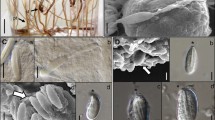Abstract
Experiments were performed on specimens ofCalliactis parasitica collected near Plymouth in April 1987 and in the Mediterranean between September 1987 and April 1988. Undischarged nematocysts (basitrichous isorhizas) were separated from the acontia of by using 1M glycerol, 1M citrate, 0.5% Nonidet or 0.5% Triton X-100 as isolating agents, or by freezing the acontial tissue. The mechanisms of extrusion were not studied. The effectiveness of 50 mM thioglycolate in discharging nematocysts isolated by the above methods and suspended in Ca- and Mg-free artificial sea water (ASW) was investigated. Nematocysts extruded in glycerol were more responsive to thioglycolate than those extruded in citrate. Capsules isolated in non-ionic detergents, however, and those obtained by freezing were not discharged by thioglycolate. If capsules extruded in glycerol were suspended in ASW and this was replaced with distilled water, they did not respond to thioglycolate. The effect of distilled water was only partly reversible. It was observed that these nematocysts, unlike those ofPelagia noctiluca andAiptasia mutabilis previously investigated, did not release measurable amounts of free Ca2+ during discharge. It is suggested that if calcium is not involved in the mechanism of discharge of isolatedC. parasitica nematocysts then some other ionic species may stabilize the resting condition of these capsules.
Similar content being viewed by others
Literature cited
Azzi, A., Chance, B. (1969). “Energized state of mitochondria Life-time and ATP equivalence. Biochim. biophys. Acta 189: 141–151
Blanquet, R. (1970). Ionic effect on discharge of the isolated andin situ nematocysts of the sea anemoneAiptasia pallida: possible role of calcium. Comp. Biochem. Physiol. 35: 351–461
Blinks, J. R., Prendergast, F. G., Allen, D. G. (1976). Photoproteins as biological calcium indicators. Pharmacol. Rev. 28: 2–87
Godknecht, A., Tardent, P. (1988). Discharge and mode of action of tentacular nematocysts ofAnemonia sulcata (Anthozoa: Cnidaria). Mar. Biol. 100: 83–92
Gupta, B. L., Hall, T. A. (1984). Role of high concentrations of Ca, Cu and Zn, in the maturation and discharge in situ of sea anemone nematocysts as shown by X-ray microanalysis of cryosections. In: Bolis L., Zadunaisky J., Gilles R (eds.) Toxins, drugs and pollutants in marine animals. Springer-Verlag, Berlin, p. 77–95
Hidaka, M., Mariscal, R. N. (1988). Effects of ions on nematocysts isolated from acontia of the sea anemoneCalliactis tricolor by different methods. J. exp. Biol. 136: 23–34
Lubbock, R., Amos, W. B. (1981). Removal of bound calcium from nematocyst contents causes discharge. Nature, Lond. 290: 500–501
Lubbock, R., Gupta, B. L., Hall, T. A. (1981). Novel role of calcium in exocytosis: mechanism of nematocysts discharge as shown by X-ray microanalysis. Proc. Nat. Acad. Sci. USA A 78: 3624–3628
Mariscal, R. (1984). Cnidaria: Cnidae. In: Bereiter-Hahn, J., Maltowsky, A. G., Richards, K. S. (eds.) Biology of the integument: I. Invertebrates. Springer, Berlin, p. 57–68
Phelan, M. A., Blanquet, R. (1985). Characerization of nematocyst proteins from the sea anemoneAiptasia pallida andPachycerianthus torreyi. Comp. Biochem. Physiol. 81B: 661–666
Salleo, A., Calabrese, L., Barra, D., La Spada, G. (1986a). Characterization of protein components of the capsule fluid and of the capsule wall of the nematocysts ofPelagia noctiluca. Nova Thalassia. 8: 119–122
Salleo, A., La Spada, G., Alfa, M. (1983). Blockage of trypsin induced discharge of nematocysts ofPelagia noctiluca by Ca2+. Molec. Physiol. 3: 89–97
Salleo, A., La Spada, G., Falzea, G., Denaro, M. G. (1984a). Discharging effect of anions and inhibitory effect of divalent cations on isolated nematocysts ofPelagia noctiluca. Molec. Physiol. 5: 23–34
Salleo, A., La Spada, G., Falzea, G., Denaro, M. G. (1984b). Discharging effectiveness of lyotropic anions on nematocysts ofPelagia noctiluca. Molec. Physiol. 6: 19–26
Salleo, A., La Spada, G., Denaro, M. G., Falzea, G. (1986b). Effect produced by SCN-and thioglycolate on isolated nematocysts ofPelagia noctiluca. Cell. Molec. Biol. 32: 661–666
Salleo, A., La Spada, G., Denaro, M. G., Falzea, G. (1988a). Dynamics of the release of free calcium during the discharge of holotrichous isorhiza nematocysts ofPelagia noctiluca. In: Hessinger, D. A., Lenhoff, H. M. (eds.) The Biology of Nematocysts. Academic Press Inc., San Diego, p. 551–565
Salleo, A., La Spada, G., Denaro, M. G. (1988b). Release of free Ca2+ from the nematocysts ofAiptasia mutabilis during the discharge. Physiol. Zool. 61: 272–279
Shimomura, O., Johnson, F. H., Saiga, Y. (1963). Microdetermination of calcium by aequorin luminescence. Science, N.Y. 140: 1339–1340
Watson, G. M., Mariscal, R. N. (1984). Calcium cytochemistry of nematocyst development in catch tentacles of the sea anemoneHaliplanella luciae (Cnidaria: Anthozoa) and the molecular basis for tube inversion into the capsule. J. Ultrastruct. Res. 86: 202–214
Watson, G. M., Mariscal, R. N. (1985). Ultrastructure of nematocyst discharge in catch tentacles of the sea anemoneHaliplanella luciae (Cnidaria: Anthoza). Tissue Cell 17: 199–213
Weber, J., Klug, M., Tardent, P. (1987a). Detection of high concentration of Mg and Ca in the nematocysts of various cnidarians. Experientia 43: 1022–1025
Weber, J., Klug, M., Tardent, P. (1987b). Some physical and chemical properties of purified nematocysts ofHydra attenuata Pall. (Hydrozoa, Cnidaria). Comp. Biochem. Physiol. 88B: 855–862
Yanagita, T. M. (1973). The “cnidoblast” as an excitable system. Publ. Seto mar. biol. Lab. 20: 675–693
Yanagita, T. M., Wada, T. (1954). Effects of trypsin and sodium thioglycolate upon the nematocysts of the sea anemone. Nature Lond. 173: 171
Author information
Authors and Affiliations
Additional information
Communicated by M. Sará, Genova
Rights and permissions
About this article
Cite this article
Salleo, A., La Spada, G. & Robson, E.A. Discharge characteristics of nematocysts isolated from acontia ofCalliactis parasitica . Mar. Biol. 104, 459–464 (1990). https://doi.org/10.1007/BF01314350
Accepted:
Issue Date:
DOI: https://doi.org/10.1007/BF01314350




